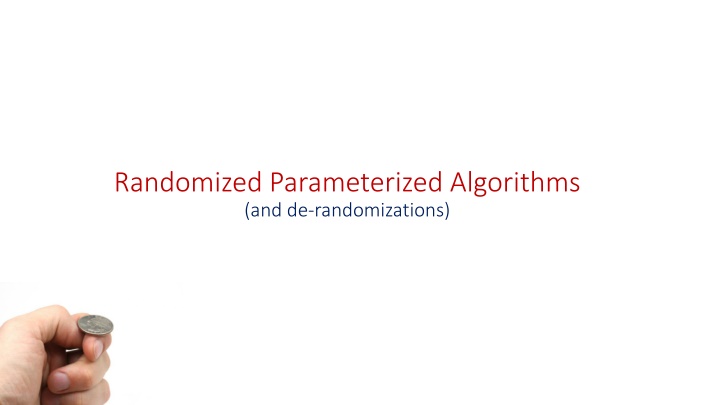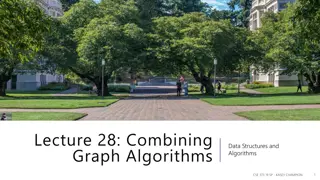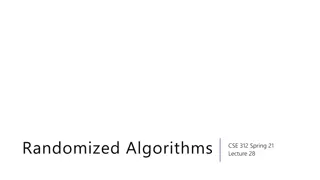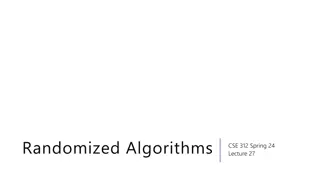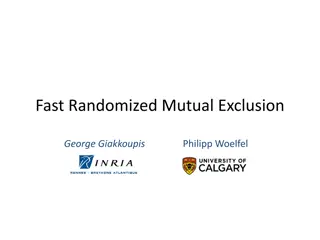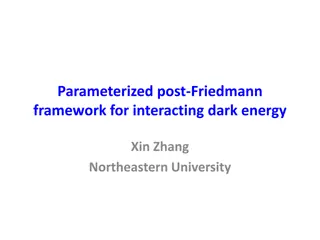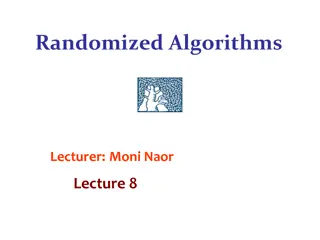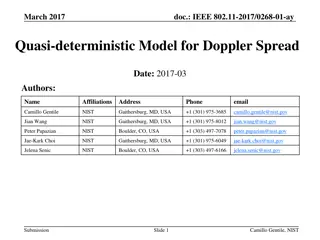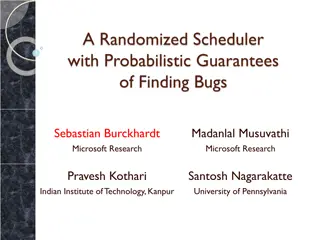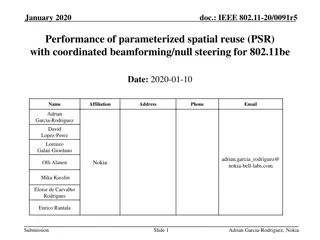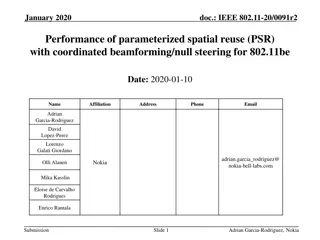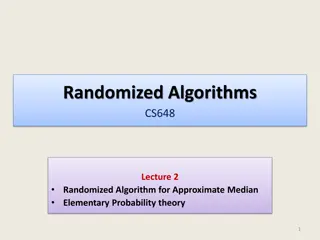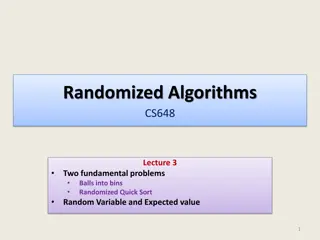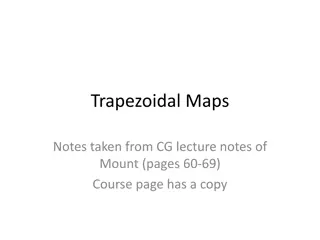Randomized Parameterized Algorithms
This content delves into the realm of randomized parameterized algorithms and their de-randomizations. Explore the intricacies of how these algorithms work and their various applications in the world of computer science.
Download Presentation

Please find below an Image/Link to download the presentation.
The content on the website is provided AS IS for your information and personal use only. It may not be sold, licensed, or shared on other websites without obtaining consent from the author.If you encounter any issues during the download, it is possible that the publisher has removed the file from their server.
You are allowed to download the files provided on this website for personal or commercial use, subject to the condition that they are used lawfully. All files are the property of their respective owners.
The content on the website is provided AS IS for your information and personal use only. It may not be sold, licensed, or shared on other websites without obtaining consent from the author.
E N D
Presentation Transcript
Randomized Parameterized Algorithms (and de-randomizations)
Color Coding Design randomized algorithm first, then try to de-randomize it.
k-Path Input: G, k Question: Is there a path on k vertices in G? Parameter: k Will give an algorithm for k-path with running time (2e)k+o(k)nO(1).
Randomized Algorithm Consider a random function f : V(G) {1...k} For a set S on k vertices, what is the probability that all vertices get a different color? Good colorings of S. k! kk 1 ?? Possible colorings of S. Stirling approximation
Randomized Algorithm Repeat ek t times: Pick random f : V(G) {1...k} Look for a colorful k-path. For x 2: 1? 1 4 1 1 ? ? If the algorithm finds a k-path, then G definitely has one. If there is a k-path, the algorithm will find it with probability at least ?? ? 1 1 1 1 1 ?? ??
Finding a Co ol lorful k-Path Exercise Give a kO(k)time algorithm to determine whether a k-colored graph has a colorful k-path.
Finding a Colorful k-Path Dynamic programming on the colors used by partial solutions. vertex If exists path on |S| vertices ending in v, using all colors from S. true T[S,v] = false otherwise subset of {1...k}
Dynamic Programming T[S,v] = T[S\f v ,u] u N(v) Is there a path ending in u that uses all colors in S, except v s color? For each neighbor u of v O(n) time to fill each entry. 2kn table entries Total time: 2kn2
Randomized Algorithm Repeat ek 100 times: Pick random f : V(G) {1...k} Look for a colorful k-path. Takes 2kn2 time If the algorithm finds a k-path, then G definitely has one. If there is a k-path, the algorithm will find it with probability at least 1 ?100 1 Total time: O((2e)kn2).
De-randomization How can we make the algorithm deterministic? Let F = f1...ftbe a family of functions with fi: V(G) {1...k}. F is a k-universal hash family F if for every set S V(G) of size k, there is an fi F such that fimakes S colorful.
Deterministic Algorithm Takes t time Construct a k-universal hash family F. For each f F: Look for a colorful k-path. Takes 2kn2 time If the algorithm finds a k-path, then G definitely has one. If there is a k-path, the algorithm will find it. Total time: O(t + |F| 2kn2).
Constructing Hash Functions [NSS 95] Can construct a k-perfect hash family F of size ek+o(k)log n in time ek+o(k)n log n. k-Path in time (2e)k+o(k)nO(1) 5.44knO(1)
Random Separation: Set Splitting Input: Family S1...Smof sets over a universe U = v1...vn, integer k. Question: Is there a coloring c : U {0,1} such that at least k sets contain an element colored 0 and an element colored 1? Parameter: k Will give a 2knO(1)time randomized, and a 4knO(1)time deterministic algorithm.
Randomized Algorithm Pick a random coloring c : V(G) {1,2}. If c splits at least k sets, return c. If the algorithm returns a coloring, then it is correct. Claim: If there is a coloring that splits at least k sets, then a random coloring will split at least k sets with probability at least 1 2? The 2knO(1)time randomized algorithm follows directly from the claim.
Proof of claim Suppose splits the sets S1...Sk. Make a bipartite graph G=(A B, E) as follows: A is a minimal hitting set for S1...Skcolored 0 B is a minimal hitting set for S1...Skcolored 1 For i from 1 to k Add one edge between a vertex in Si A and a vertex in Si B.
Proof of claim, continued. If c properly colors G then all sets S1...Skare split. G has k edges and at most 2k vertices G has k+x vertices G has x components Probability that c properly colors G is at least: 2x Number of proper colorings 2k+x= 1 2k Number of colorings
Set Splitting Randomized Algorithm Repeat 100 2ktimes: Pick a random coloring c : V(G) {1...k}. If c splits at least k sets, return c. Running time: O(2knm) If the algorithm returns a coloring, then it is correct. If there is a coloring that splits k sets, the algorithm will find one with probability 1-1/2100.
Universal Coloring Family Let F = {c1...ct} be a family of colorings V(G) {0,1} F is a k-universal coloring family if for every set S on at most k vertices and every way of coloring S there is some ci F which colors S exactly like that.
Set Splitting Algorithm Takes t time Construct 2k-universal coloring family F For each c F: If c splits at least k sets, return c. If the algorithm returns a coloring, then it is correct. If there is a coloring that splits k sets, the algorithm will find one, since the graph G has 2k vertices. Running time: O(t + |F|nm)
Construction of Universal Coloring Families [NSS 95] Can construct a k-universal coloring family F of size 2k+o(k)log n in time 2k+o(k)n log n. (We need a 2k-universal coloring family) Set Splitting in time 4k+o(k)nO(1).
Induced Subgraph Isomorphism Input: Graphs G and H, G has maximum degree , |V(H)| = k Question: Does G contain H as an induced subgraph? Parameters: + |V(H)| Naive algorithm: nO(k) Encodes the k-Clique problem (so FPT just by k is unlikely) |V(G)| Will see a O(k)time algorithm
Random Separation Will assume H is connected Color vertices of G red with probability p, blue with probability 1-p Delete all blue vertices Determine whether any (red) connected component is equal to H using Graph Isomorphism in time 2polylog(k)
Success Probability If G does not contain H then algorithm always says no If G contains H then: All the vertices of H are colored red with probability pk All the neighbors of H (in G) are colored blue with probability at least(1 p) k Success probability: ??(1 p) k= 1 k(1 1 1 ) k (4 )k Set p = 1/
Running time Each run of the algorithm takes 2o(k)time. Repeat (4 )ktimes for constant success probability. Total runtime: (4 )k+o(k)
Derandomization Universal Coloring Families Subgraph Isomorphism with running time 2O( k). deterministic algorithm for Induced This can be improved to O(k).
Other variants Simple extension 1: Algorithm for the case where H is not necessarily connected with essentially the same running time. Simple extension 2: Algorithm for Subgraph Isomorphism problem (not induced) with similar ish running time.
Feedback Vertex Set Feedback Vertex Set (FVS) IN: G, k Q: Is there a set S of k vertices such that G\S is a forest?
FVS reduction rules R1: Delete vertices of degee 1 R2: Replace degree 2 vertices by edges (keep multiedges)
-cover Lemma A set S V(G) is an -cover if v Sd(v) v V(G)d(v) (= 2m) Lemma: If R1 and R2 do not apply, then every feedback vertex set S of G is a -cover.
-cover Lemma Lemma: If S is a feedback vertex set of G and R1 and R2 do not apply outside S, then S of G is a -cover. If R1 and R2 do not apply then every feedback vertex is a -cover. Proof: v Sd(v) v V(G)d(v) -2 S -2 +2
Algorithm for FVS while G is not empty Apply R1 and R2 on G exhaustively Select a vertex v with prob = d(v) / 2m. S := S {v} G := G\v If |S| > k output NO output S Succeeds with probability
Feedback Vertex Set Runs in O(k(n+m)) time, succeeds with 1 4?probability. So O(4kk(n+m)) time for constant success probability. Expected output solution size is 4OPT, this is a 4-approximation!
Feedback Vertex Set below 2n Feedback Vertex Set (FVS) IN: G, k Q: Is there a set S of k vertices such that G\S is a forest? Saw a 4knO(1)time algorithm Can we beat 2n? Branching is tricky Next: O((2-1 4)n) = O(1.75n) time using 4knO(1) as black box
Feedback Vertex Set algorithm Given n, k, pick integer t k. Pick a set S of size t uniformly at random, put S in solution. (By deleting S and decreasing parameter by t) Try to extend S to a feedback vertex set of size k (By running 4knO(1)time algorithm on (G-S, k-t))
Analysis Number of subsets of solution of size t ? ? ? ? Number of subsets of size t Success probability: Running time: 4k-tnO(1) ? ? ? ? Running time for constant success probability: 4? ? Given n, consider the worst k: ? ? ? ? Given n and k pick t so that running time is minimized: ? ? ? ? 4? ? max ? ?min ? ? 4? ? min ? ?
Analysis, contd ? ? ? ? ?? ? ?((2 1 ?)?) Lemma: For all c > 1, max ? ?min ? ? Feedback Vertex Set in ?((2 1 Corollary: 4)?) = O(1.75n) time.
Generalizing Nothing in the algorithm / analysis was specific to FVS! Look for a set of size k in a universe of size n. If we can extend a set of size t to a solution of size k in time ck-tnO(1) then We can find a solution in time O((2 1 c)n) Can be fully derandomized.
Chromatic Coding Random Separation Techiques Picking Random Solution Vertices Color Coding Mod 2 Counting + Isolation
Thank you!
